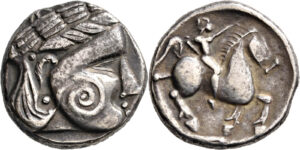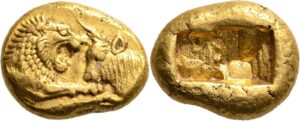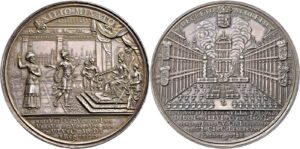170,000 Euros for a Decuple Ducat from Brandenburg-Frankonia
Frankfurt-based auction house Dr. Busso Peus Nachf. offered in their autumn auction 425 from 7 to 8 November 2019 coins and medals from antiquity to the middle ages, modern times, and numismatic literature.

The Celtic collection, the prelude to this year’s autumn auction, met with lively interest, with the AV-staters enjoying great popularity. No. 142, the rare rainbow bowl from the northwestern group in exceptional condition brought the proud result of 4600 €. Eye-catching results were also achieved with the East Celtic tetradrachms. The tetradrachm of the Wangenschnecke (No. 169) was sold for € 6500.

Among the Greek coins, special attention was paid to the extremely beautiful pieces from the Aurum Graecum collection, which, in addition to their mostly outstanding preservation, often also had first-class provenances. For example, the 1 1/3 litre piece of Gela from the Pozzi collection fetched € 14,000. The exquisite Cyrenean AV-tetrobol from the time of Magas, which belonged to the collection of the important Danish politician Gustav Philipsen, fetched € 9,000. Special mention should also be made of the Achaimenid AV-stater no. 297 with hammer of € 24,000 and the two AV-staters from the Seleucid Empire no. 303 and no. 311, which were each hammered for € 17,000. Finally, the coins from Axum also attracted considerable attention.
The Roman coins started with the special collection of republican bronze coins, which was distinguished above all by its high type density and numerous rarities. Meticulously compiled, the numerous rarities are certainly still missing in most of the repuplic’s collections. Nevertheless, it became apparent once again that the rarity of the pieces in comparison to their quality obviously plays a rather subordinate role for most buyers. The rare bronze of Octavianus and Divus Julius Caesar from Lyon as Colonia Copia Felix Munatia (no. 631), which reached € 900, is to be emphasized however. The Roman emperors, on the other hand, brought solid results again and Roman gold pieces were also in demand despite their rather low quality. Late Roman, Byzantine and above all the tremisses (no. 792 yielded a total of € 5000 with an estimate of € 250) as well as the two gold bracteates of the Migration period successfully rounded off the ancient part of the auction.
The following coins of foreign countries sold equally well, without any special tendencies to be seen. Highlights were a magnificently preserved Chinese “Junk Dollar” (lot 1012), which had received the outstanding grade MS 66 and was raised up by the bidders to € 3,800. Also a large undated (about 1768) silver medal of the Russian Liberal Economic Society brought as a splendid specimen with magnificent patina proud € 5,500 (lot 1171). Thereafter, coins and medals of the Habsburg hereditary lands followed in which an increasing interest in general, but especially in the East Central European coinage, is to be seen. Here, the coins almost consistently sold above the estimates and this sometimes only after long bidding struggles. To illustrate this, a silver medal 1689 by Christian Fischer on the devastation of the French and Turkish armies on the Rhine and in Hungary which was increased from € 3,000 to 4,800 (lot 1262) should be mentioned. Also a basically not scarce Taler of Leopold I, 1703, Kremnitz mint, scored in extremely fine condition a result of € 1,200 (lot 1266). A rare double ducat 1786, Milan mint, which more than doubled its estimate with a result of € 4,200 may be mentioned as a last example (lot 1280).

After the equally sought after Talers of Transylvania, the larger series of Judaic medals followed. Here, the medals on great events and personalities were of great interest, while some low-taxed pieces remained unnoticed. From this series a silver medal 1745 by van Swinderen on the expulsion of the Jews from Bohemia with a surcharge of € 19,000 (lot 1332) and another silver medal 1805 by Merker on the emancipation of the Jews in Russia with € 7,500 surcharge stood out individually. Subsequently, the collection of South German and northern Swiss bracteates came to auction. Here, above all, committed collectors who recognized the rarities with visible specialist knowledge had their moment and closed gaps in their private collections also in the low-priced segment.

In the area of old German coins came the highlight of this auction, early Talers of Brandenburg-Prussia. The four- and five-digit results chased each other. A Taler 1604, Cöln (Berlin today) mint was increased from € 5,000 to 12,000 (lot 1610), the following Taler 1614, Cöln mint to € 10,000. The list could be continued. At the end of this series the title piece, a 10-fold Ducat, struck 1598 in Königsberg mint by the Margrave Georg Friedrich of Brandenburg-Franconia on his administrative dignity in the Duchy of Prussia became the climax of the auction. Two telephone bidders raised the price from € 50,000 to 170,000. After the varied medals, gold and silver coins of the Holy Roman Empire the German imperial coins followed, which once again confirmed the clear trend to top conditions. As usual, a series of lively bidded combined lots and this time an offer of numismatic literature closed the auction. In general, the number of internet live bidders, including both collectors and dealers from Germany and abroad, continue to increase further. This resulted in a successful auction with fine results, which especially benefits the numerous consigners, whom the auction house wants to thank once again.
The digital catalog is available on the auction house’s website.
There you can also find the online catalog and the post-auction sale.




